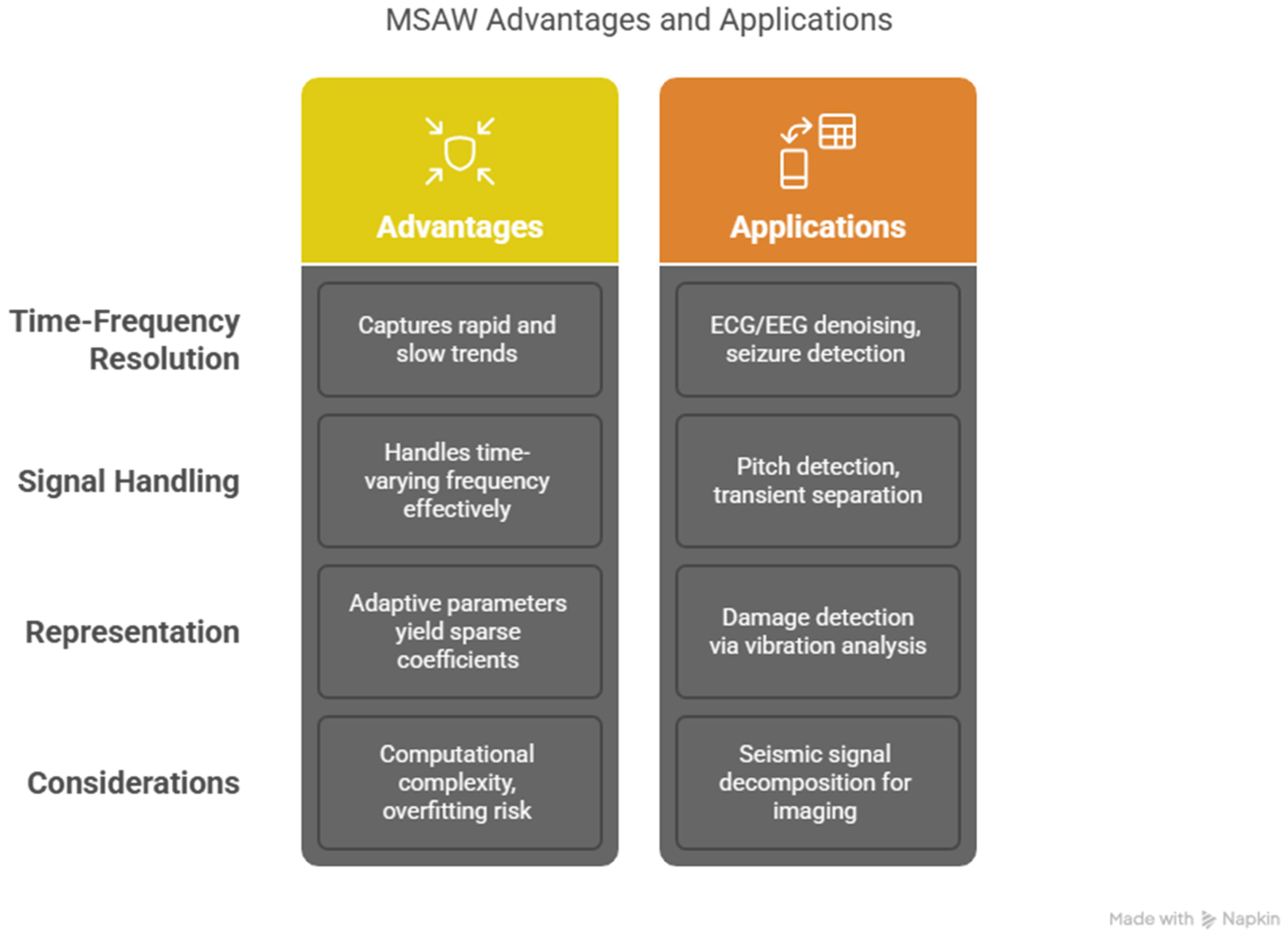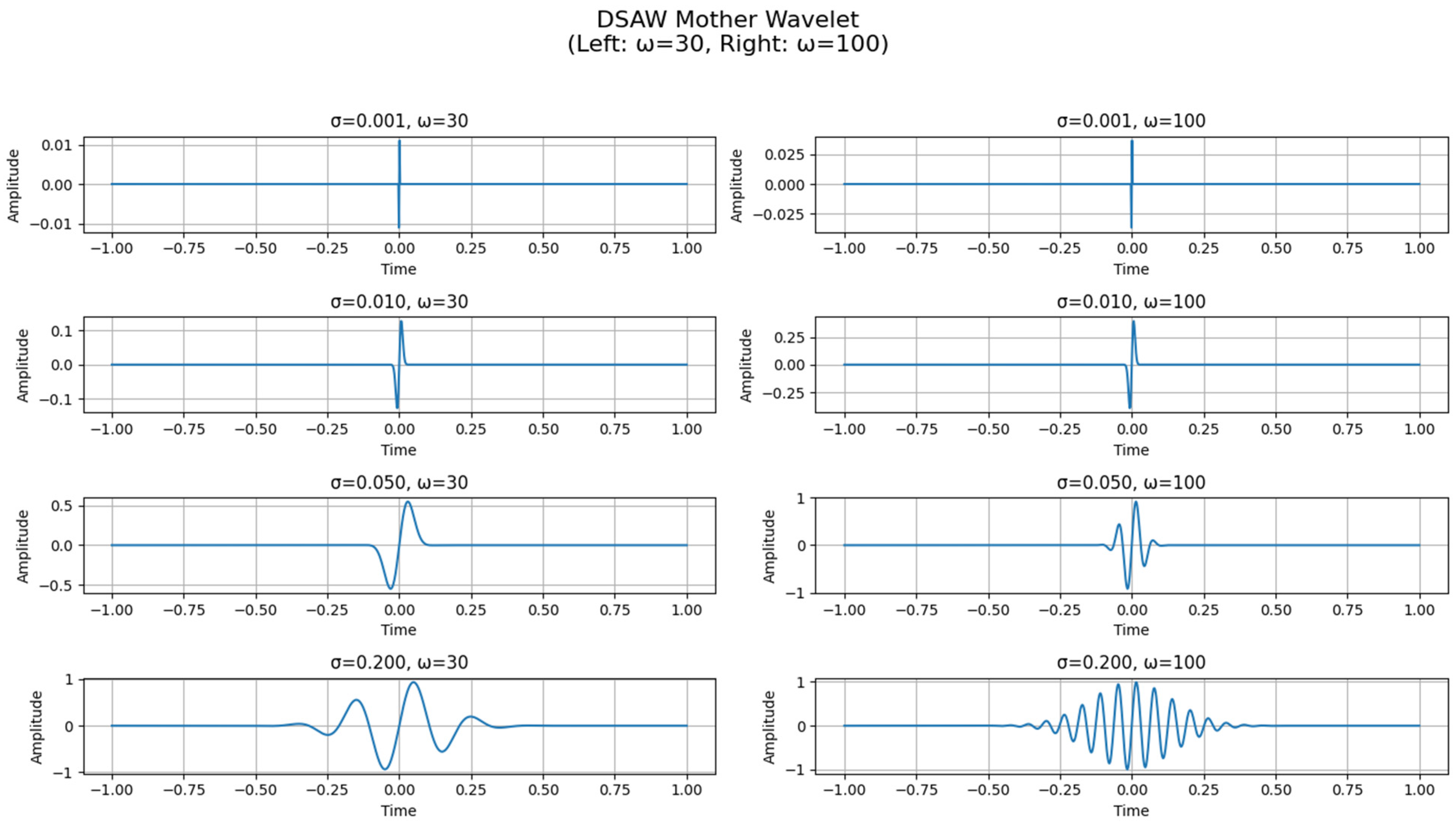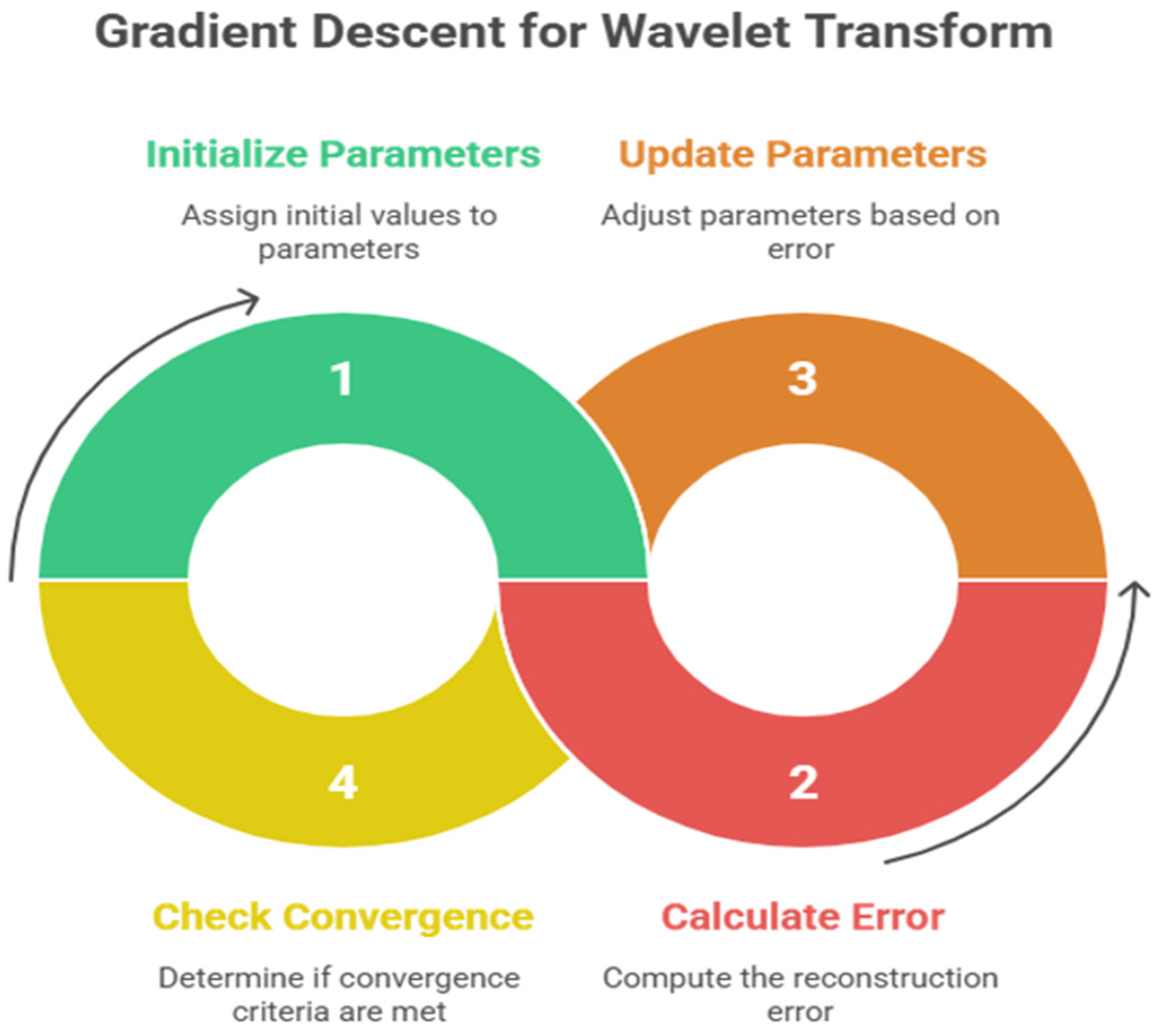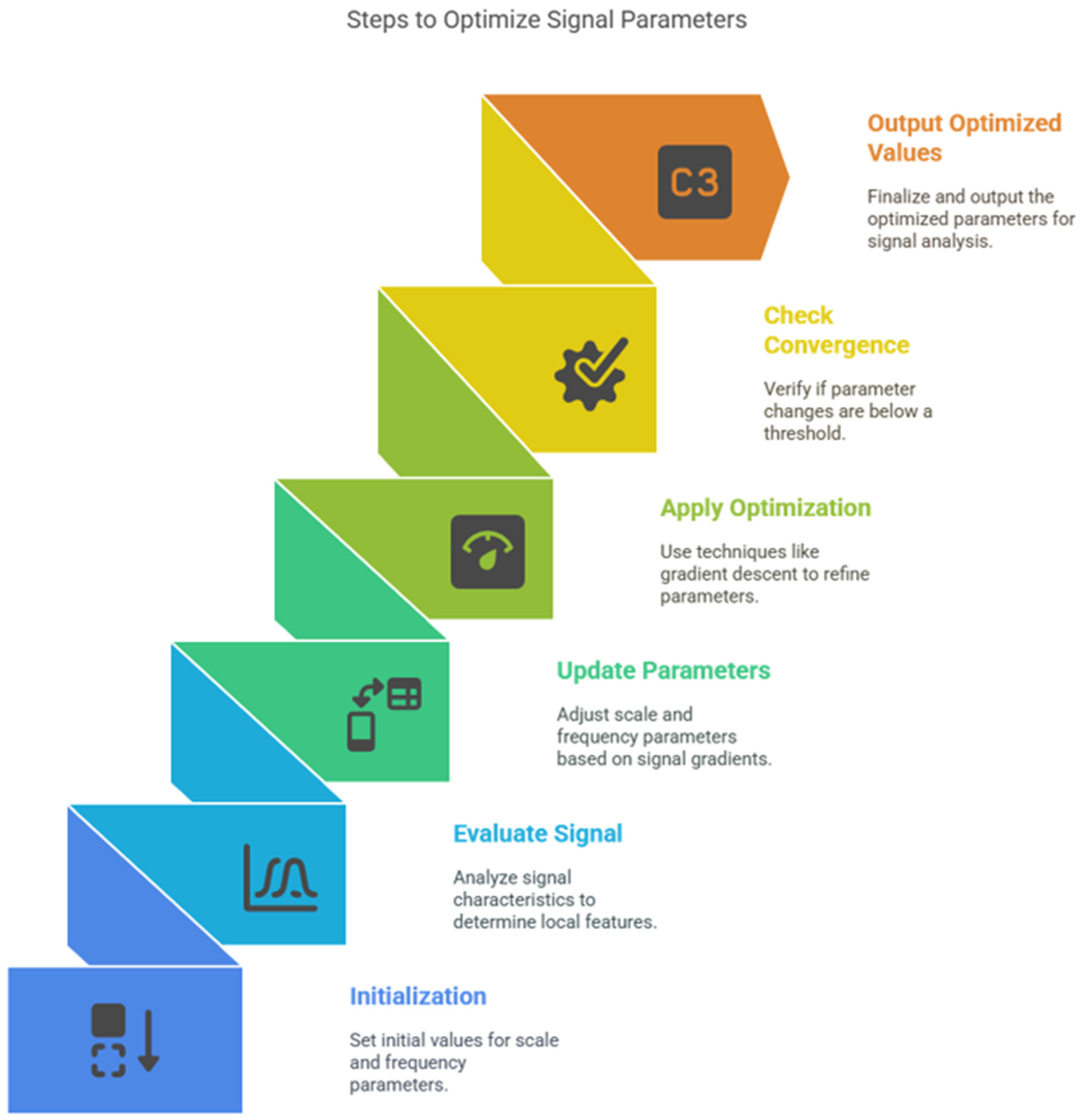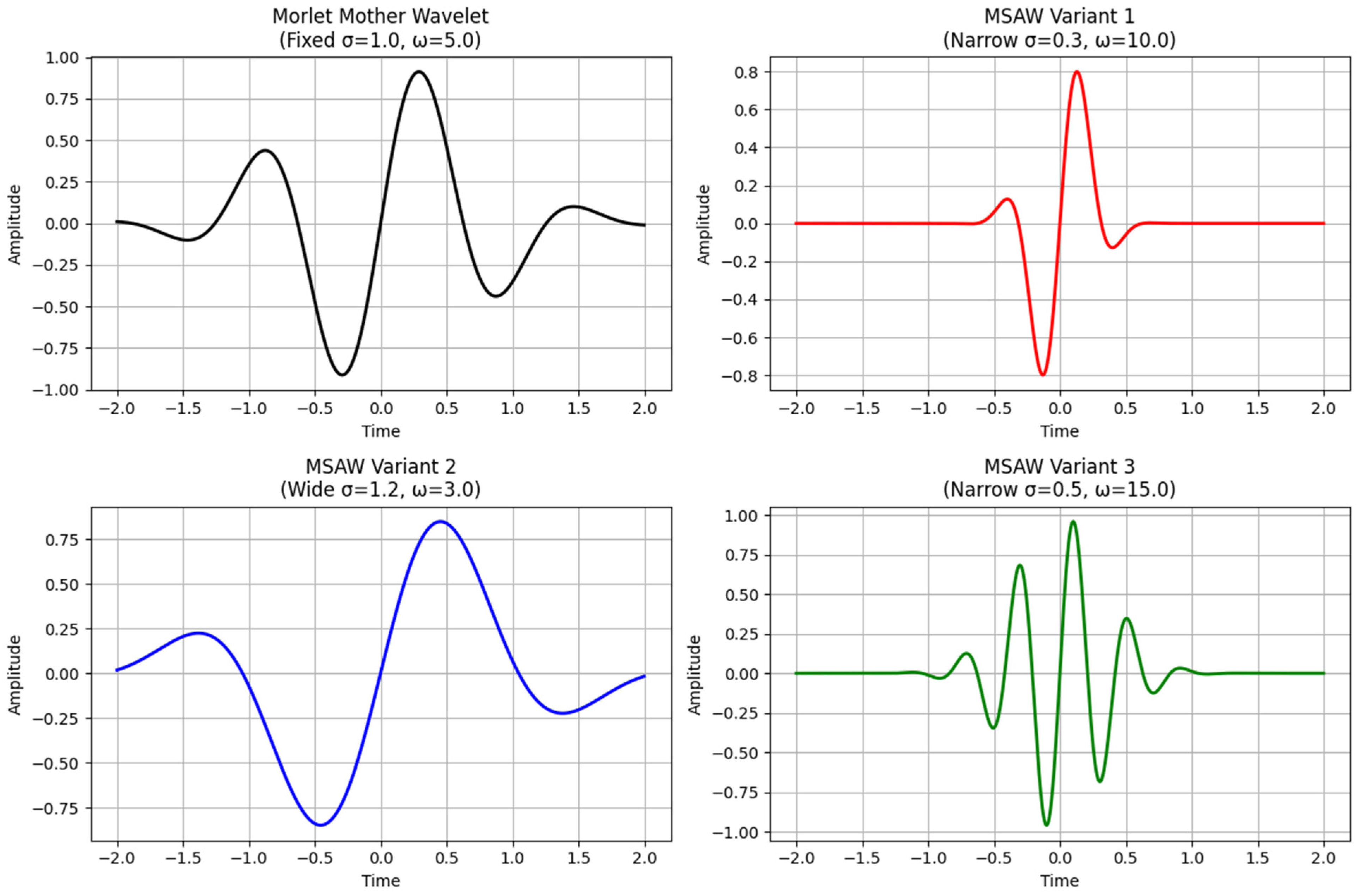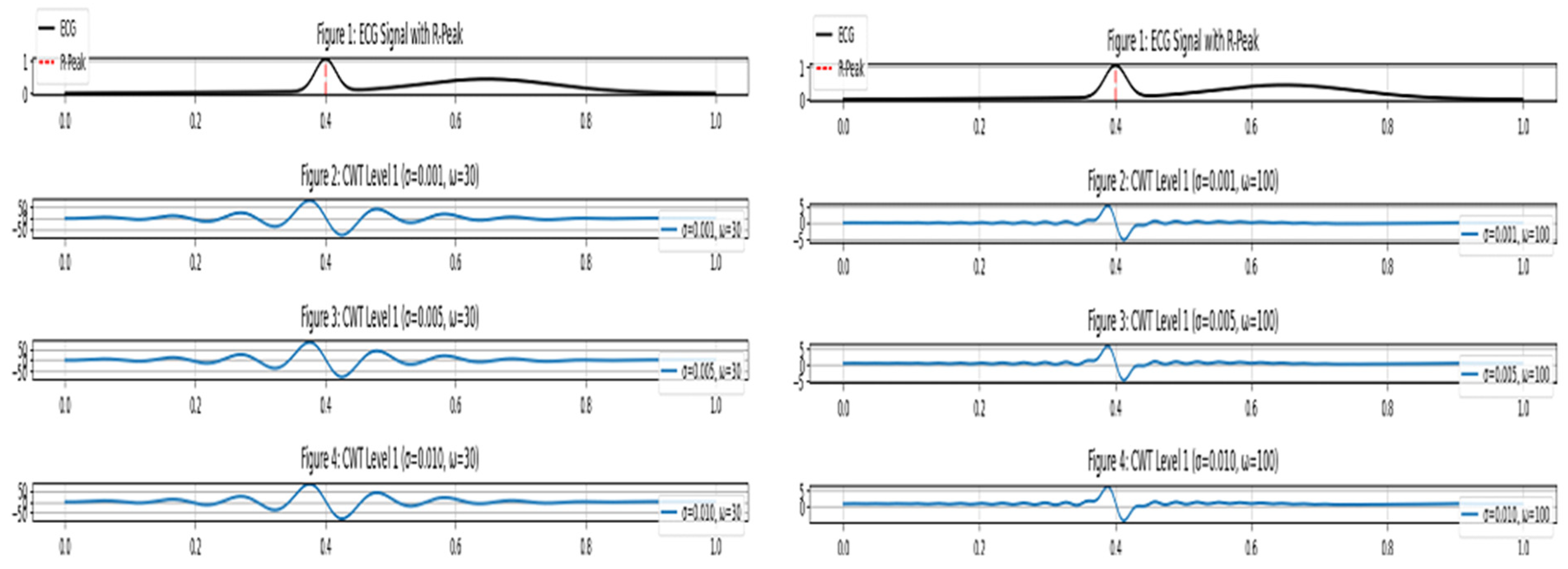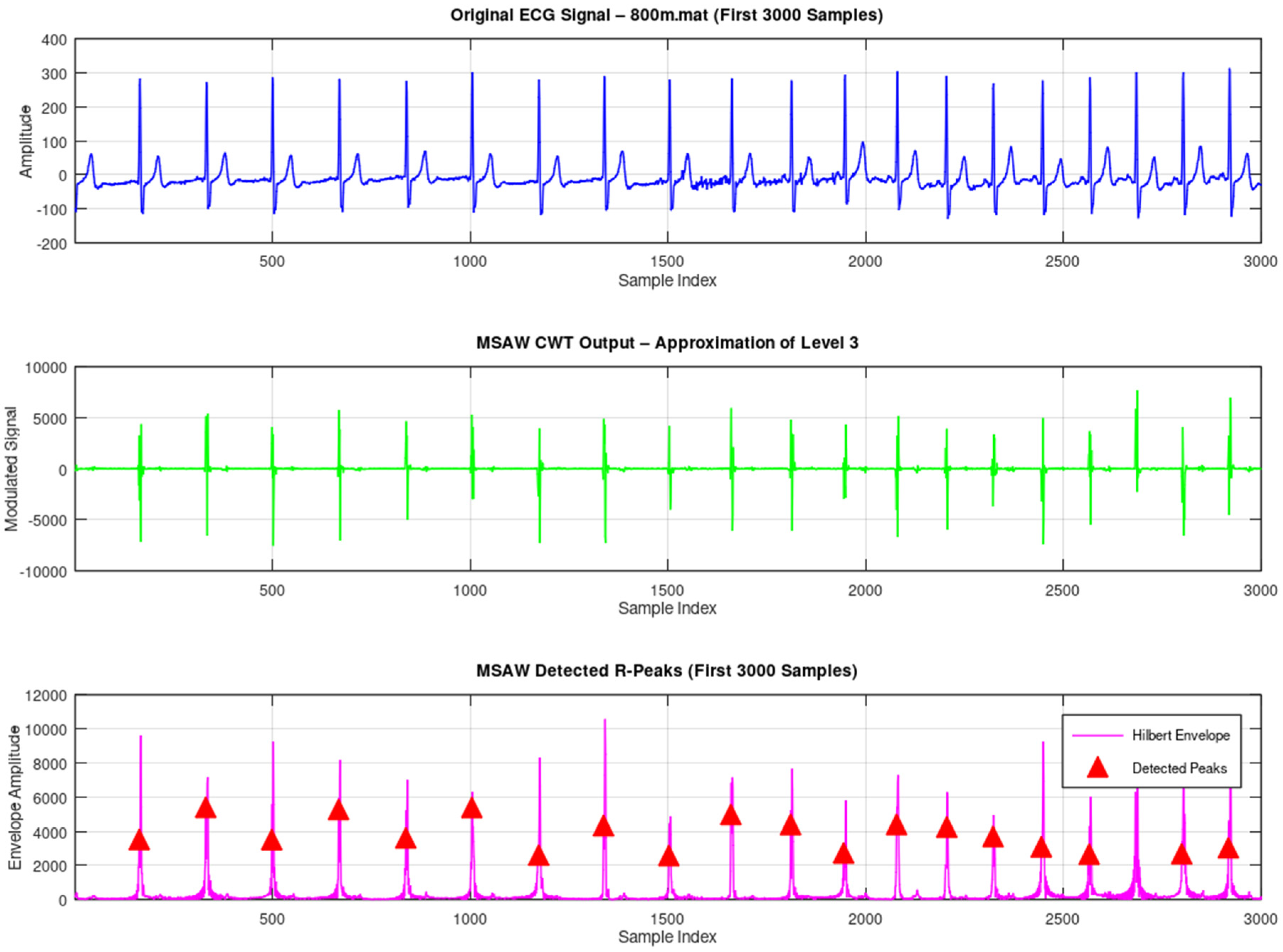The illustration presents ECG signal analysis through wavelet decomposition where MSADW is evaluated against Morlet wavelet for three detail coefficient levels.
Detection Aspect Improvement by MSADW
The core innovation of MSADW gets its strength from real-time adjustability of scale parameters
and frequency parameters
that lead to superior ECG component matching compared to traditional wavelets [
11,
12]. The authors selected MSADW scale 2 for manual signal convolution because this selection proved most effective at detecting the ECG high-frequency transient QRS complexes (see
Figure 8,
Figure 9 and
Figure 10). The signal dynamics in the examined region determine how MSADW adjusts its scale parameters while maintaining distinction from conventional wavelets like Morlet or Daubechies.
The signal analysis algorithm prefers scale 2 () for detecting R-peaks due to its narrow scale, yet uses wider scales between 20 and 40 for smooth P and T waves detection.
Through proper adjustment of the frequency modulation parameter “ω(t)” the system can detect ECG spectral content characteristics for optimal transient detection (see
Figure 7).
The adjustable characteristics of the system improved detection accuracy by:
The MSADW CWT sub signal detected the R-peak at 0.29 s, resulting in a detection error of 0.01 s at 0.30 s (QRS Complex). Scale 2 of the MSADW wavelet successfully detected QRS high-frequency energy, whereas non-optimal fixed wavelets would have failed to achieve this level of exactness.
The detection of the P-Wave and T-Wave occurs when zero crossing points occur at 0.14 s and 0.61 s, respectively. The envelope scaling algorithm of MSADW
conserved low-frequency signal elements, thus creating precise distortion-free baseline transitions (see
Figure 7).
The ECG signal detection approach in MSADW achieves robustness by integrating amplitude-maximum detection techniques with zero-crossing threshold methods within various ECG signal patterns.
The QRS complex showed a reliable point of detection through the maximum negative amplitude peak, which could be identified accurately. Zero-crossing detection techniques proved less effective because they missed both inverted and fragmented QRS complexes, so MSADW outperformed them. The heart rate variability and arrhythmia detection depend on the sub-sample level
precision achieved by MSADW in R-wave identification (see
Figure 7).
The process of detecting smooth P and T-waves used a zero-crossing approach together with MSADW’s Gaussian envelope to eliminate baseline shifts. The combined signal processing system replicates the natural signal patterns.
Traditional wavelets (e.g., Morlet) need distinct scales or post-operation processing to achieve identical precision because they do not have two operational abilities.
The dynamic parameterization of MSADW solved the well-known time–frequency trade-off problem that occurs with static wavelet functions.
The compressed wavelets from MSADW operated at scale 2 to achieve a localized R-peak detection with superior results compared to traditional wavelets because it reduced detection errors to 0.01 s. The QRS identification process with Morlet-based CWT sometimes needs multiple scale evaluations, which creates an extra workload for computations (see
Figure 7).
The application of MSADW at bigger scales produced an enlarged wavelet along with lower frequency sensitivity, which effectively monitored smooth P and T-waves while bypassing baseline drift limitations of standard wavelets.
When evaluated at scale 2, the MSADW CWT sub signal confirmed these results:
The feedback-controlled optimization process, which normalizes using L2 norms () in MSADW, produces superior signal processing resilience to:
Traditional wavelet systems demonstrate difficulties when facing this type of variability challenge. For example:
The use of Morlet wavelets at fixed scales results in misalignment between P-waves and baseline shifts that occur in atrial fibrillation.
The non-selective frequency characteristics of Daubechies wavelets affect their ability to detect T-wave repolarization patterns accurately.
The results explicitly validated MSADW’s improvements over conventional approaches and are tabulated in
Table 3.
The actual design of MSADW resolves several limitations associated with ECG clinical processing.
Real-time atrial fibrillation or ventricular tachycardia diagnosis requires R-peak timing analysis, which benefits from the QRS detection (0.30 s) solution based on amplitude measurements.
The zero-crossing detection method identified the T-wave inversion without threshold limitations to prevent false negative results during ischemic events.
The manual implementation of MSADW CWT, combined with simple peak detection using zero-crossing and amplitude maximization, allows the deployment of the system on minimal resource devices.
Through three innovative breakthroughs, the study establishes MSADW as superior for ECG feature detection.
The system automatically controls both and parameters to optimize the time–frequency resolution based on the ECG component.
The detection method uses both P, T waves from zero crossing and QRS complex from amplitude maxima to achieve complete feature extraction.
Robust Sub signal Alignment used a CWT sub signal at scale 2 to locate R-peaks with high precision, so multi-scale fusion became unnecessary.
The proposed MSADW platform demonstrates its function as a self-optimizing ECG analysis tool. The proposed tool delivers superior results to standardized wavelets regarding both accuracy and clinical applicability as well as adaptive characteristics. Further work should apply these research results to natural medical data while developing automatic methods to choose appropriate scales for improved system performance.
In further evidence of the refutation, we also incorporated the running tests of the widely known database of ECG signal processing, namely the MIT-BIH Arrhythmia Database. There is one record i.e., 800 which is used for testing. The ECG signals are chosen from the MIT-BIH Supraventricular Arrhythmia Database [
13]. The ECG signal is obtained using a conventional 12-lead electrocardiogram with a sampling rate of 360 Hz. To assess the performance of the MSADW, we compared it with the Morlet CWT using one record from the Supraventricular Arrhythmia Database called 800. We compared the two mechanisms by applying each of them with a peak detection mechanism based on zero-crossings, and a thresholding mechanism based on the amplitude, on the first 1000 R peaks of the ECG trace. The results acquired are quantitative, as seen in
Table 4:
These results indicate that, on the one hand, MSADW is more sensitive than Morlet CWT in the case of R-peaks detection, as it recognizes more R-peaks; on the other hand, it can be seen that the sensitivity of the MSADW in comparison with Morlet CWT is lower. In both approaches, positive predictivity was shown as 100%, but due to its superior F1-score, MSADW performed better than the other, in a sense, in overall results. It can be said that MSADW shows enhanced performance in the adaptive scale and frequency modulation characteristics, which meet many transient components such as R-peaks. On the contrary, Morlet wavelets rely on the iterative parameters, which do not encourage the ability to incorporate local properties of the signal. Furthermore, the refinement mechanism of the feedback mechanism of MSADW reduces the reconstruction error at every pass and in so doing, introduces resilience to noise and baseline wander as can be observed in ECG signals in real life. In
Table 5, the performance metrics are tabulated.
Figure 10,
Figure 11 and
Figure 12 illustrate the original ECG and its CWT by MSADW and Morlet, and the Hilbert envelope used for R-peak detection.
Where:
The noise robustness of three signal processing techniques, MSADW, Morlet, and Daubechies, was tested under a systematic noise–stress condition of injecting baseline wandering at the signal-to-noise (SNR) of 10 dB using two different approaches: determining the minimal amount of noise to cause signal breakage and estimating the allowable rms noise measurement of signal satisfactory preservation. The assessment will be done using the following statistical measures: Se, P+, F1-score, mean squared error (MSE), baseline wander attenuation (BWA%), and signal interference (SI), with which all results can be compared thoroughly under noisy scenarios.
Noise robustness was greatest overall on MSADW compared to the other two approaches that were tested. It provided the highest signal preservation at a sensitivity of 91.2% and an F1-score of 90.4%, meaning that the component showed a strong sensitivity of true signals. Also, MSADW demonstrated the highest suppression of the noise (94.6%), in the baseline wander (a crucial kind of low-frequency noise present in the physiological signal, such as ECG or EEG). Even though MSADW caused a little bit more signal interference (SI = 4.9), its ratio of noise reduction to signal fidelity was better compared to the other two approaches.
The Morlet wavelet strategy was slightly more effective, as it managed to keep the content of the signal with a sensitivity of 85.4% and an F1-score of 83.7%. It was able to suppress the baseline wander effectively, indicating 88.3% suppression of the baseline wander, which is quite good but less compared to that of MSADW. It has a lower SI of 3.7, which indicates that it adds less distortion on denoising; nevertheless, it has lower noise suppression and noise detection accuracy levels.
Daubechies wavelet trailed MSADW and Morlet in most of the metrics. It was least sensitive (81.6%), had the lowest F1-score (80.4%), and the highest mean squared error (0.00028), which means worse signal reconstruction is performed. Although it displayed the lowest degree of signal interference (SI = 2.8), it also eliminated the minimum degree of baseline wander (83.0%), indicating that its conservative practice gives high priority to low signal distortion, at the expense of its noise removal capability (see
Table 6).
Table 7 below gives an overview of the approximate average run-time and RAM that was used in conducting the 10-s ECG-segment by using the three wavelet-based approaches. The tests were made using an Intel i5/i7 Huawei laptop of 16 GB RAM.
A conclusion about the performance of three signal processing algorithms, MSADW, Morlet, and Daubechies (db6), applied to analyze an artificial ECG signal, is presented in the table. MSADW offers the best run-time of 52.35 ms and a low RAM consumption of 12.54 MB and is thus a very viable option in terms of fast processing. Conversely, the Morlet method has the longest run-time of 127.09 ms with an increased RAM usage of 18.08 MB, which is characteristic of an advanced analysis. The Daubechies db6 method takes the longest period of execution (145.36 ms) and highest memory combination (21.86 MB), meaning its ability to describe the details is high as well as being resource-consuming. All procedures were evaluated on an ordinary CPU with a signal of 10 s of length in the Python 3.x executable.
